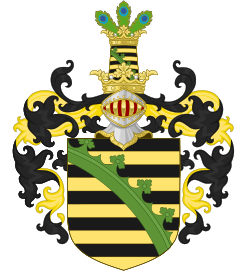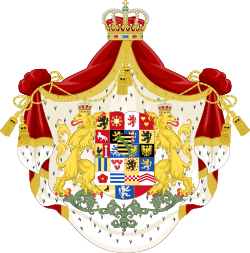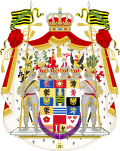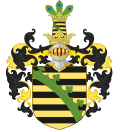| Ruler | Born | Reign | Ruling part | Consort | Death | Notes |
|---|
| Theodoric I | | c.920
? | c.950 – 976 | County of Wettin | Judith of Magdeburg
c.950
two children | 976
aged 55-56 | First known member of the family and first count of Wettin. |
| Dedo I |  | c.960
First son of Theodoric I and Judith of Magdeburg | 976 – 13 November 1009 | County of Wettin | Thietburga of Haldensleben
c.980
one child | 13 November 1009
Zörbig
aged 48-49 | Children of Theodoric, divided their inheritance. Eilenburg eventually rejoined Wettin after Frederick's death. |
| Frederick | | c.960
Second son of Theodoric I and Judith of Magdeburg | 976 – 5 January 1017 | County of Wettin
(at Eilenburg) | Unknown
three children | 5 January 1017
Eilenburg
aged 56-57 |
| Theodoric II |  | c.980
Son of Dedo I and Thietburga of Haldensleben | 13 November 1009 – 19 November 1034 | County of Wettin | Matilda of Meissen
c.1000
seven children | 19 November 1034
aged 53-54 | Since 1032 also Margrave of Lusatia. |
| Dedo II | | 1004
First son of Theodoric II and Matilda of Meissen | 19 November 1034 – October 1075 | March of Lusatia | Oda of East Ostmark
c.1035
two children
Adela of Leuven
c.1055
two children | October 1075
aged 70-71 | Children of Theodoric II, Dedo II and Thimo divided their inheritance. Since 1040, Dedo II associated his namesake son to his rule in Lusatia. |
| Dedo III the Younger | | c.1035
Son of Dedo II and Oda of East Ostmark | 1040 – 1069 | Unmarried | 1069
aged 33-34 |
| Thimo the Brave |  | c.1030
Second son of Theodoric II and Matilda of Meissen | 19 November 1034 – 9 March 1090 | County of Wettin | Ida of Nordheim
three children | 9 March 1090
aged 59-60 |
| Regency of Adela of Leuven (1075–1084) | |
| Henry I the Elder |  | 1070
Son of Dedo II and Adela of Leuven | October 1075 – 1103 | March of Lusatia
(with Meissen since 1089) | Gertrude of Brunswick
c.1090
one child | 1103
aged 32-33 |
| Dedo IV [ de ] |  | c.1070
First son of Thimo and Ida of Nordheim | 9 March 1090 – 26 December 1124 | County of Wettin | Bertha of Groitzsch [ de ]
c.1120
(annulled)
one child | 26 December 1124
aged 53-54 | |
| Regency of Gertrude of Brunswick (1103–1117) | Posthumous son of his father, left no descendants. |
| Henry II the Younger | | 1103
Posthumous son of Henry I and Gertrude of Brunswick | 1103 – October 1123 | March of Lusatia
(with Meissen) | Adelaide of Stade
c.1120
no children | October 1123
aged 19-20 |
| Lusatia and Meissen fell under control of other families (1123–1136); Annexed again to Wettin in 1136 |
| Conrad I the Great |  | c.1080?
Second son of Thimo and Ida of Nordheim | 26 December 1124 – 1156 | County of Wettin
(with March of Lusatia and Meissen since 1136) | Luitgard of Elchingen-Ravenstein
(c.1104–1146)
1115
twelve children | 5 February 1157
Petersberg
aged 76-77? | Heirs of Dedo IV. Conrad abdicated in 1156 to his sons, who divided the county. Dedo's daughter Matilda's possessions were inherited by her descendants. |
| Matilda |  | c.1120?
Daughter of Dedo IV [ de ] and Bertha of Groitzsch [ de ] | 26 December 1124 – 9 January 1170 | County of Wettin
(at Leisnig and Colditz) | Rapoto, Count of Abenberg [ de ]
(c.1104–1146)
c.1150
twelve children | 9 January 1170
aged 49-50 |
| Otto the Rich [11] |  | c.1125?
First son of Conrad I and Luitgard of Elchingen-Ravenstein | 1156 – 18 February 1190 | March of Meissen | Hedwig of Brandenburg
1155
four children | 18 February 1190
Nossen
aged 64-65 | Children of Conrad I, divided their inheritance. After Theodoric's death with no descendants, the march of Lusatia was inherited by his brother Dedo. |
| Theodoric I | 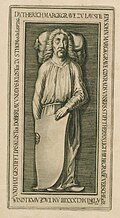 | c.1125?
Second son of Conrad I and Luitgard of Elchingen-Ravenstein | 1156 – 9 February 1185 | March of Lusatia | Dobroniega Ludgarda of Poland
c.1145
two children | 9 February 1185
Petersberg
aged 59-60 |
| Dedo V the Fat |  | c.1125?
Third son of Conrad I and Luitgard of Elchingen-Ravenstein | 1156 – 16 August 1190 | County of Groitzsch [ de ]
(until 1185)
March of Lusatia
(from 1185) | Matilda of Heinsberg [ nl ]
c.1150
six children | 16 August 1190
aged 64-65 |
| Henry I [ fr ] |  | c.1130?
Fourth son of Conrad I and Luitgard of Elchingen-Ravenstein | 1156 – 30 August 1181 | County of Wettin | Sophia of Sommerschenburg
(d.1195)
c.1150
four children | 30 August 1181
aged 57-58 |
| Frederick I [ de ] |  | c.1130?
Fifth son of Conrad I and Luitgard of Elchingen-Ravenstein | 1156 – 4 January 1182 | County of Brehna [ de ] | Hedwig of Bohemia [ cz ]
1165
three children | 4 January 1182
aged 55-56 |
| Henry II [ bg ] |  | c.1150?
First son of Henry I [ fr ] and Sophia of Sommerschenburg | 30 August 1181 – 20 December 1187 | County of Wettin | Unmarried | 20 December 1187
Giebichenstein
aged 36-37 | |
| Hedwig of Bohemia [ cz ] |  | c.1150?
Daughter of Theobald of Bohemia and Gertrude of Brandenburg [ cz ] | 4 January 1182 – 19 February 1211 | County of Brehna [ de ]
(at the town of Brehna) | Frederick I [ de ]
1165
three children | 19 February 1211
aged 60-61 | Heirs of Frederick I. Otto shared the town of Brehna with his mother as widow seat. |
| Otto I [ de ] | | c.1165
First son of Frederick I [ de ] and Hedwig of Bohemia [ cz ] | 4 January 1182 – 23 December 1203 | County of Brehna [ de ]
(in the remaining county) | Unmarried | 23 December 1203
Brehna
aged 37-38 |
| Ulrich [ de ] |  | c.1160?
Second son of Henry I [ fr ] and Sophia of Sommerschenburg | 20 December 1187 – 28 September 1206 | County of Wettin | ? of Winzenburg
(1149–1204)
c.1185
no children
Hedwig of Saxony
1205
one child | 28 September 1206
Wettin
aged 45-46 | |
| Albert I the Proud |  | 1158
First son of Otto and Hedwig of Brandenburg | 18 February 1190 – 24 June 1195 | March of Meissen | Sophia of Bohemia [ cz ]
23 April 1186
Ústí nad Labem
one child | 24 June 1195
Halsbrücke
aged 36-37 | After his death, his lands were seized by Henry VI, Holy Roman Emperor. As he left no male descendants, the march, when recovered, passed to his brother. |
| Meissen briefly under direct rule of the Holy Roman Empire |
| Theodoric | | c.1150
First son of Dedo V and Matilda of Heinsberg [ nl ] | 16 August 1190 – 13 June 1207 | March of Lusatia
(at Groitzsch) | Judith of Thuringia
1190
two children | 13 June 1207
aged 56-57 | Children of Dedo V, possibly divided the inheritance. [12] |
| Conrad II | | c.1150
Second son of Dedo V and Matilda of Heinsberg [ nl ] | 16 August 1190 – 6 May 1210 | March of Lusatia
(at Eilenburg) | Elisabeth of Greater Poland
February 1180
three children | 6 May 1210
aged 59-60 |
| Agnes |  | 1152
Daughter of Dedo V and Matilda of Heinsberg [ nl ] | 16 August 1190 – 25 March 1195 | March of Lusatia
(at Rochlitz) | Berthold IV, Duke of Merania
1180
seven children | 2 March 1195
Dießen am Ammersee
aged 42-43 |
| Groitzsch and Eilenburg annexed to Meissen; Rochlitz annexed to the House of Andechs, but eventually returned to the House of Wettin |
| Theodoric I & II the Oppressed [13] |  | 11 March 1162
Second son of Otto and Hedwig of Brandenburg | 1198 – 18 February 1221 | March of Meissen | Judith of Thuringia
1197
five children | 18 February 1221
Nossen
aged 58 | |
| Regency of Hedwig of Saxony and Frederick II, Count of Brehna [ de ] (1205–1217) | Died as a minor and left no descendants. After his death, Wettin was inherited by the Brehna line. |
| Henry III |  | 1205
Son of Ulrich [ de ] and Hedwig of Saxony | 28 September 1206 – 25 March 1217 | County of Wettin | Unmarried | 25 March 1217
aged 11-12 |
| Frederick II & I [ de ] |  | c.1165?
Second son of Frederick I [ de ] and Hedwig of Bohemia [ cz ] | 23 December 1203 – 25 March 1217 | County of Brehna [ de ]
(in co-rulership since 1182) | Judith of Ziegenhain
(d. 6 October 1220)
c. 1190
four children | 16 December 1221
Acre
aged 60-61 | Co-ruling in Brehna since 1182, with his brother Otto. Ruling alone since 1203, Frederick inherited the county of Wettin from his cousin Henry III. |
| 25 March 1217 – 16 December 1221 | County of Wettin |
Regency of Judith of Thuringia (1221–1223) and Louis IV, Landgrave of Thuringia (1221–1227)
Regency of Albert I, Duke of Saxony (1227–1230) | In 1265, he informally divided his patrimony with his sons: Albert received rule over Thuingia and Theodoric over Landsberg, but as Theodoric predeceased his father, Albert divided, in 1288, the margraviate with his nephew, Frederick Tuta. |
| Henry III the Illustrious |  | 1215
Meissen
Son of Theodoric I and Judith of Thuringia | 18 February 1221 – 15 February 1288 | March of Meissen | Constance of Austria
1 May 1234
near Vienna
two children
Agnes of Bohemia [ cz ]
1244
no children
Elisabeth von Maltitz [ de ]
1270
two children | 15 February 1288
Dresden
aged 72-73 |
| Theodoric III [ pl ] |  | c.1190?
First son of Frederick II & I [ de ] and Judith of Ziegenhain | 16 December 1221 – 11 July 1267 | County of Wettin | Eudoxia of Masovia [ de ]
(c.1210–1250)
c.1230
six children | 11 July 1267
aged 76-77 | Children of Frederick II, ruled jointly. |
| Otto II | | c.1190?
Second son of Frederick II & I [ de ] and Judith of Ziegenhain | 16 December 1221 – 1234 | Unmarried | 1234
aged 43-44? |
| Otto III | | c.1230?
First son of Theodoric III [ pl ] and Eudoxia of Masovia [ de ] | 11 July 1267 – 1288 | County of Wettin | Unmarried | c.1290
aged 59-60 | Children of Theodoric, divided their inheritance. Theodoric II's possessions were absorbed by the Templar Order, where he went. Otto's death with no descendants led to the absorption of the county by the Archbishopric of Magdeburg. |
| Conrad I | | c.1230?
Second son of Theodoric III [ pl ] and Eudoxia of Masovia [ de ] | 11 July 1267 – 26 March 1278 | County of Brehna [ de ] | Elisabeth of Saxe-Wittenberg
c.1270
four children | 26 March 1278
aged 47-48 |
| Theodoric IV | | c.1230?
Third son of Theodoric [ pl ] and Eudoxia of Masovia [ de ] | 11 July 1267 – c.1270 | County of Wettin
(at Mücheln and Döblitz) | Unmarried | 1272
aged 41-42 |
| Wettin annexed to the Archbishopric of Magdeburg; Mücheln and Döblitz annexed to the Templar Order |
| Conrad II | | c.1250?
First son of Conrad I and Elisabeth of Saxe-Wittenberg | 26 March 1278 – 1288 | County of Brehna [ de ] | Unmarried | 1288
aged 37-38 | Children of Conrad I, ruled jointly. Left no descendants, and their county was annexed to Saxe-Wittenberg. |
| Otto IV | | c.1250?
Second son of Conrad I and Elisabeth of Saxe-Wittenberg | 26 March 1278 – 1290 | 1290
Erfurt
aged 39-40 |
| Brehna annexed to Saxe-Wittenberg |
| Albert II the Degenerate |  | 1240
Son of Henry III and Constance of Austria | 15 February 1288 – 1307 | March of Meissen
(in Thuringia only since 1291) | Margaret of Sicily
June 1255
five children
Kunigunde of Eisenberg
1272
(having an affair since 1269)
two children
Elisabeth of Weimar-Orlamünde [ de ]
1 October 1290
no children | 20 November 1314
Erfurt
aged 73-74 | Following the formal division made by his father, it was expected for both sons of Henry to divide Meissen between them, but Theodoric preceded his father; it was his son Frederick Tuta who made the true division of power with his uncle Albert after Henry III's death. The marriage of Albert II with his previous lover and his estrangement with his legitimate sons led to a succession crisis that led to Albert's deposition, but Albert kept his power in Thuringia, which he was also forced to surrender in 1307. After said deposition, and Frederick Tuta's death with no descendants (1291), the sons of Albert II (Frederick I and Theodoric III) redivided Meissen. |
| Frederick Tuta | | 1269
Son of Theodoric of Landsberg and Helene of Brandenburg | 15 February 1288 – 16 August 1291 | March of Lusatia | Catharina of Bavaria
1155
four children | 16 August 1291
Nossen
aged 64-65 |
| Frederick I the Brave |  | 1257
Eisenach
First son of Albert II and Margaret of Sicily | 16 August 1291 – 16 November 1323 | March of Meissen
(with Thuringia since 1307) | Agnes of Gorizia-Tyrol [ de ]
1 January 1286
Vienna
one child
Elisabeth of Lobdeburg-Arnshaugk [ de ]
24 August 1301
Gotha
two children | 16 November 1323
Eisenach
aged 65-66 | Children of Albert II, deposed their father, and, aftet their cousin's death, divided the whole patrimony between them. In 1303, Theodoric sold his property to the Margraviate of Brandenburg. |
| Theodoric III |  | 1260
Second son of Albert II and Margaret of Sicily | 16 August 1291 – 1303 | March of Lusatia | Judith of Henneberg-Schleusingen
(d.1315)
1295 no children | 10 November 1307
Leipzig
aged 46-47 |
| Lusatia annexed to the Margraviate of Brandenburg |
| Regency of Elisabeth of Lobdeburg-Arnshaugk [ de ] (1323–1329) | |
| Frederick II the Serious |  | 30 November 1310
Gotha
Son of Frederick I and Elisabeth of Lobdeburg-Arnshaugk [ de ] | 16 November 1323 – 18 November 1349 | March of Meissen | Matilda of Bavaria
May 1323
Nuremberg
nine children | 18 November 1349
Wartburg
aged 38 |
| Frederick III the Strict |  | 14 December 1332
Dresden
First son of Frederick II and Matilda of Bavaria | 18 November 1349 – 21 May 1381 | March of Meissen | Catherine of Henneberg
1346
four children | 21 May 1381
Altenburg
aged 48 | |
| Balthasar |  | 21 December 1336
Weißenfels
Second son of Frederick II and Matilda of Bavaria | 21 May 1381 – 18 May 1406 | Landgraviate of Thuringia | Margaret of Nuremberg
Spring 1374
two children
Anna of Saxe-Wittenberg
1404
no children | 18 May 1406
Wartburg
aged 69 | Following Frederick III's death, his heirs made the Division of Chemnitz, which divided the property of the family between surviving brothers and sons of the deceased margrave. After the Wittenberg line of the Ascanians became extinct, the Electorate of Saxony was given to Frederick IV, one of the sons of Frederick III. William I's property (given he died with no children) fell to his nephews fom Landsberg. |
| William I the One-eyed |  | 19 December 1343
Dresden
Third son of Frederick II and Matilda of Bavaria | 21 May 1381 – 9 February 1407 | March of Meissen | Elisabeth of Moravia
1390
no children
Anna of Brunswick-Göttingen [ bg ]
1403
no children | 9 February 1407
Grimma
aged 63 |
| Regency of Catherine of Henneberg (1381–1384) |
| Frederick IV & I the Warlike |  | 11 April 1370
Dresden
First son of Frederick III and Catherine of Henneberg | 21 November 1381 – 4 January 1428 | March of Landsberg | Catherine of Brunswick-Lüneburg
7 February 1402
seven children | 4 January 1428
Altenburg
aged 57 |
| 6 January 1423 – 4 January 1428 | Duchy of Saxony and Electorate of Saxony |
| William II the Rich | | 23 April 1371
Dresden
Second son of Frederick III and Catherine of Henneberg | 21 May 1381 – 13 March 1425 | March of Meissen
(co-ruling in the Margraviate of Landsberg until 1407) | Amelia of Masovia
16 May 1413
Brześć Kujawski
(by proxy)
no children | 13 March 1425
aged 53 |
| George [ fr ] |  | 1380
Dresden
Third son of Frederick III and Catherine of Henneberg | 21 May 1381 – 9 December 1401 | March of Landsberg | Unmarried | 9 December 1401
Coburg
aged 20-21 |
| Meissen and Landsberg fell to the Electorate of Saxony |
| Frederick IV the Peaceful | | c.1380
Weißenfels
Son of Balthasar and Margaret of Nuremberg | 18 May 1406 – 7 May 1440 | Landgraviate of Thuringia | Anna of Schwarzburg-Sondershausen [ de ]
1407
no children | 7 May 1440
Weißensee
aged 59-60 | |
| Frederick II the Gentle |  | 22 April 1412
Leipzig
First son of Frederick IV & I and Catherine of Brunswick-Lüneburg | 4 January 1428 – 7 September 1464 | Duchy of Saxony and Electorate of Saxony
(with Thuringia in 1440–1445) | Margaret of Austria
3 June 1431
Leipzig
eight children | 7 September 1464
Leipzig
aged 52 | Children of Frederick I, had different inheritances. Frederick was the sole inheritor of the Electorate, but also inherited also Thuringia from his cousin Frederick IV, but gave it to his brother William a few years later. After William's death with no children, Thuringia merged in the Electorate. |
| William III the Brave |  | 30 April 1425
Meissen
Second son of Frederick IV & I and Catherine of Brunswick-Lüneburg | 1445 – 17 September 1482 | Landgraviate of Thuringia | Anna of Austria
2 June 1446
no children | 17 September 1482
Weimar
aged 57 |
| Thuringia annexed to the Electorate of Saxony |
| Ernest I |  | 24 March 1441
Meissen
First son of Frederick II and Margaret of Austria | 7 September 1464 – 26 August 1486 | Electorate of Saxony
(Ernestine line) | Elisabeth of Bavaria-Munich
25 November 1460
Leipzig
seven children | 26 August 1486
Colditz Castle
aged 45 | Children of Frederick II, divided their patrimony. Ernest, as the eldest, inherited the Electoral dignity. Ernest founded the Ernestine line of Saxon princes, and Albert was the founder of the Albertine line. |
| Albert III the Bold |  | 27 January 1443
Grimma
Second son of Frederick II and Margaret of Austria | 7 September 1464 – 12 September 1500 | Duchy of Saxony
(Albertine line) | Sidonie of Poděbrady
11 November 1464
Cheb
nine children | 12 September 1500
Emden
aged 57 |
| Frederick III the Wise |  | 17 January 1463
Torgau
First son of Ernest I and Elisabeth of Bavaria-Munich | 26 August 1486 – 5 May 1525 | Electorate of Saxony
(Ernestine line; at Wittenberg) | Unmarried | 5 May 1525
Annaburg
aged 62 | Children of Ernest, ruled jointly, with different seats from 1513. Frederick was a protector of Martin Luther, but a lifelong Catholic. John established Lutheranism officially in 1527. |
| John I the Steadfast |  | 30 June 1468
Meissen
Second son of Ernest I and Elisabeth of Bavaria-Munich | 26 August 1486 – 16 August 1532 | Electorate of Saxony
(Ernestine line; at Weimar) | Sophie of Mecklenburg
1 March 1500
Torgau
one child
Margaret of Anhalt-Köthen
13 November 1513
Torgau
four children | 16 August 1532
Schweinitz
aged 64 |
| George the Bearded |  | 27 August 1471
Dresden
First son of Albert III and Sidonie of Poděbrady | 12 September 1500 – 17 April 1539 | Duchy of Saxony
(Albertine line) | Barbara of Poland
21 November 1496
Dresden
ten children | 17 April 1539
Dresden
aged 67 | Proponent of Catholic Reform and a staunch opponent of Martin Luther. Left no surviving male descendants. He was succeeded by his brother Henry. |
| John Frederick I the Magnanimous |  | 30 June 1503
Torgau
Son of John I and Sophie of Mecklenburg | 16 August 1532 – 3 March 1554 | Electorate of Saxony
(Ernestine line; until 1547)
Duchy of Saxony
(Ernestine line; from 1547) | Sibylle of Cleves
9 February 1527
Torgau
four children | 3 March 1554
Weimar
aged 50 | Children of John I, ruled jointly. John Ernest ruled a separate part of the Electorate as Duke, never having held the Electoral dignity. John Frederick lost his Electoral dignity and territory to his cousin Maurice after being defeated by the Emperor in the Schmalkaldic War. He was left with some territories as the Duchy of Saxony. Coburg re-merged in the Saxon duchy after John Ernest's death. After John Frederick's death the Duchy of Saxony was divided between his three sons. |
| John Ernest I |  | 10 May 1521
Coburg
Son of John I and Margaret of Anhalt-Köthen | 16 August 1532 – 8 February 1553 | Duchy of Saxony
(Ernestine line; at Coburg) | Catherine of Brunswick-Grubenhagen
12 February 1542
Torgau
no children | 8 February 1553
Coburg
aged 31 |
| Henry IV the Pious |  | 16 March 1473
Dresden
Second son of Albert III and Sidonie of Poděbrady | 17 April 1539 – 18 August 1541 | Duchy of Saxony
(Albertine line) | Catherine of Mecklenburg
9 January 1541
Marburg
nine children | 18 August 1541
Dresden
aged 68 | Succeeded his brother George. He established Lutheranism in Albertine Saxony. |
| Maurice |  | 21 March 1521
Freiberg
First son of Henry IV and Catherine of Mecklenburg | 18 August 1541 – 9 July 1553 | Duchy of Saxony
(Albertine line; until 1547)
Electorate of Saxony
(Albertine line; from 1547) | Agnes of Hesse
9 January 1541
Marburg
two children | 9 July 1553
Lehrte
aged 32 | Though a Lutheran, allied with Emperor Charles V against the Schmalkaldic League. Gained the Electorate for the Albertine line in 1547 after Charles V's victory at the Battle of Mühlberg. Left no male descendants. He was succeeded by his brother Augustus. |
| Following their displacement by the Albertines, the Ernestine branch of the Wettins continued to rule in southern Thuringia as "Dukes of Saxony", but their lands eventually split up into many different tiny Ernestine duchies. |
| Augustus I |  | 31 July 1526
Freiberg
Second son of Henry IV and Catherine of Mecklenburg | 9 July 1553 – 11 February 1586 | Electorate of Saxony | Anna of Denmark
7 October 1548
Torgau
fifteen children
Agnes Hedwig of Anhalt
3 January 1586
Dessau
no children | 11 February 1586
Dresden
aged 59 | Recognized as Elector by the ousted John Frederick I in 1554. |
| John Frederick II |  | 8 January 1529
Torgau
First son of John Frederick I and Sibylle of Cleves | 3 March 1554 – November 1566 | Duchy of Coburg and Eisenach | Agnes of Hesse
26 May 1555
Weimar
no children
Elisabeth of the Palatinate-Simmern-Sponheim
12 June 1558
Weimar
four children | 19 May 1595
Lamberg Castle [ de ]
aged 66 | Children of John Frederick I, divided their inheritance. John Frederick III's domain went to his elder brother John Frederick II. He, however, was placed under imperial ban with intervention of his brother John William, who seized the opportunity to reunite all Saxony underr his domain. However, in 1572, the Division of Erfurt forced him to redivide Saxony with his nephews, sons of his imprisoned brother, who rreceived thei father's domain at Coburg and Eisenach. |
| John William |  | 11 March 1530
Torgau
Second son of John Frederick I and Sibylle of Cleves | 3 March 1554 – 2 March 1573 | Duchy of Weimar | Dorothea Susanne of the Palatinate-Simmern
15 June 1560
Heidelberg
five children | 2 March 1573
Weimar
aged 42 |
| John Frederick III the Younger |  | 16 January 1538
Torgau
Third son of John Frederick I and Sibylle of Cleves | 3 March 1554 – 21 October 1565 | Duchy of Gotha | Unmarried | 21 October 1565
Jena
aged 27 |
| Gotha annexed to Coburg and Eisenach |
| Coburg and Eisenach briefly annexed to Weimar (1566–1572) |
| Regency of Augustus I, Elector of Saxony (1573–1586) | Children of John Frederick II, ruled jointly until 1596, and then divided their inheritance. After the deaths of both brothers with no heirs, the duchies were divided between its neighbours Saxe-Altenburg and Saxe-Weimar. |
| John Casimir |  | 12 June 1564
Gotha
First son of John Frederick II and Elisabeth of the Palatinate-Simmern-Sponheim | 5 December 1572 – 16 July 1633 | Duchy of Coburg and Eisenach
(at Coburg) | Anna of Saxony
16 January 1586
Dresden
no children
Margaret of Brunswick-Lüneburg
16 September 1599
Coburg
no children | 16 July 1633
Coburg
aged 69 |
| John Ernest I |  | 9 July 1566
Gotha
Second son of John Frederick II and Elisabeth of the Palatinate-Simmern-Sponheim | 5 December 1572 – 23 October 1638 | Duchy of Coburg and Eisenach
(at Eisenach) | Elisabeth of Inner Mansfeld
23 November 1591
Wiener Neustadt
one child
Christine of Hesse-Kassel
14 May 1598
Rotenburg an der Fulda
no children | 23 October 1638
Eisenach
aged 72 |
| Coburg and Eisenach divided between its neighbours Saxe-Altenburg and Saxe-Weimar |
| Regency of Augustus I, Elector of Saxony (1573–1586) | After his death, his brother took the land and in the next year divided it with his nephews (sons of Frederick William). |
| Frederick William I |  | 25 April 1562
Weimar
Son of John William and Dorothea Susanne of the Palatinate-Simmern | 2 March 1573 – 7 July 1602 | Duchy of Weimar | Sophie of Württemberg
5 May 1583
Weimar
six children
Anna Maria of the Palatinate-Neuburg
9 September 1591
Neuburg an der Donau
six children | 7 July 1602
Weimar
aged 40 |
| Christian I |  | 29 October 1560
Dresden
Son of Augustus I and Anna of Denmark | 11 February 1586 – 25 September 1591 | Electorate of Saxony | Sophie of Brandenburg
25 April 1582
Dresden
seven children | 25 September 1591
Dresden
aged 30 | |
| Regency of Sophie of Brandenburg (1591–1601) | |
| Christian II |  | 23 September 1583
Dresden
First son of Christian I and Sophie of Brandenburg | 25 September 1591 – 23 June 1611 | Electorate of Saxony | Hedwig of Denmark
12 September 1602
Dresden
no children | 23 June 1611
Dresden
aged 27 |
| John II |  | 22 May 1570
Weimar
Second son of John William and Dorothea Susanne of the Palatinate-Simmern | 7 July 1602 – 18 July 1605 | Duchy of Weimar | Dorothea Maria of Anhalt
7 January 1593
Altenburg
twelve children | 18 July 1605
Weimar
aged 35 | Initially regent for his nephews (while their mother isolated herself in her widow property at Dornburg) John rapidly usurped their place in the duchy, being forced, in 1603, to divide Weimar with them. His nephews had their capital at Altenburg. The widow property reverted later to Weimar. |
| Anna Maria of the Palatinate-Neuburg |  | 18 August 1575
Neuburg an der Donau
Daughter of Philip Louis, Count Palatine of Neuburg and Anna of Jülich-Cleves-Berg | 7 July 1602 – 11 February 1643 | Duchy of Weimar
(at Dornburg) | Frederick William I
9 September 1591
Neuburg an der Donau
six children | 11 February 1643
Dornburg
aged 67 |
Regency of Christian II, Elector of Saxony (1603–1611)
Regency of John George I, Elector of Saxony (1611–1618) | Received and ruled jointly the newly created Saxe-Altenburg, after the partition of 1603 with their uncle and regent. None of them had male descendants. |
| John Philip the Delicious [14] |  | 25 January 1597
Torgau
First son of Frederick William I, Duke of Saxe-Weimar and Anna Maria of the Palatinate-Neuburg | 1603 – 1 April 1639 | Duchy of Altenburg | Elisabeth of Brunswick-Wolfenbüttel
25 October 1618
Altenburg
one child | 1 April 1639
Altenburg
aged 42 |
| Frederick |  | 12 February 1599
Torgau
Second son of Frederick William I, Duke of Saxe-Weimar and Anna Maria of the Palatinate-Neuburg | 1603 – 24 October 1625 | Unmarried | 24 October 1625
Seelze
aged 26 |
| John William | | 13 April 1600
Torgau
Third son of Frederick William I, Duke of Saxe-Weimar and Anna Maria of the Palatinate-Neuburg | 1603 – 2 December 1632 | 2 December 1632
outskirts of Brzeg
aged 32 |
| John Ernest I the Younger [15] |  | 21 February 1594
First son of John II and Dorothea Maria of Anhalt | 18 July 1605 – 6 December 1626 | Duchy of Weimar | Unmarried | 6 December 1626
aged 32 | Left no children. After his death, his brothers succeeded him jointly, but eventually divided the duchy. |
| John George I | 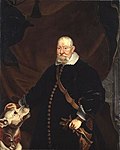 | 5 March 1585
Dresden
Second son of Christian I and Sophie of Brandenburg | 23 June 1611 – 8 October 1656 | Electorate of Saxony | Sibylle Elisabeth of Württemberg
16 September 1604
Dresden
one child
Magdalene Sibylle of Prussia
19 July 1607
Torgau
ten children | 8 October 1656
Dresden
aged 71 | Ruled during the Thirty Years' War, during which he was at times allied with the Emperor and at times with the King of Sweden. |
| William I the Great [16] |  | 11 April 1598
Altenburg
Second son of John II and Dorothea Maria of Anhalt | 6 December 1626 – 17 May 1662 | Duchy of Weimar | Eleonore Dorothea of Anhalt-Dessau
23 May 1625
Weimar
nine children | 17 May 1662
Weimar
aged 64 | Sons of John II, ruled jointly. In 1640 divided officially the land. William kept Saxe-Weimar. In 1644 William reunited his own domains with his brother Albert's. After William's death his domains were divided by his four sons. On the other hand, Ernest inherited Saxe-Gotha and reunited it with his wife's (as heiress of Saxe-Altenburg). |
| Albert IV the Unsightful [14] |  | 27 July 1599
Altenburg
Third son of John II and Dorothea Maria of Anhalt | 6 December 1626 – 20 December 1644 | Duchy of Eisenach
(co-ruling in Weimar until 1640) | Dorothea of Saxe-Altenburg
24 June 1633
Weimar
no children | 20 December 1644
Eisenach
aged 45 |
| Ernest I the Pious [17] |  | 25 December 1601
Altenburg
Fourth son of John II and Dorothea Maria of Anhalt | 6 December 1626 – 26 March 1675 | Duchy of Gotha
(co-ruling in Weimar until 1640; in Gotha 1640–1672)
Duchy of Gotha and Altenburg
(from 1672; in Altenburg jure uxoris ) | Elisabeth Sophie of Saxe-Altenburg
24 October 1636
Altenburg
eighteen children | 26 March 1675
Friedenstein Palace
aged 74 |
| Frederick William II |  | 12 February 1602
Weimar
Fourth son of Frederick William I, Duke of Saxe-Weimar and Anna Maria of the Palatinate-Neuburg | 1 April 1639 – 22 April 1669 | Duchy of Altenburg | Sophie Elisabeth of Brandenburg
18 September 1638
Altenburg
no children
Magdalene Sibylle of Saxony
11 October 1652
Dresden
three children | 22 April 1669
Altenburg
aged 66 | Brother of John Philip, Frederick and John William. Succeeded his childless brothers. Received part of Saxe-Weimar-Eisenach in 1638. |
| John George II the Worthy [14] |  | 31 May 1613
Dresden
First son of John George I and Magdalena Sibylle of Prussia | 8 October 1656 – 22 August 1680 | Electorate of Saxony | Magdalene Sibylle of Brandenburg-Bayreuth
13 November 1638
Dresden
three children | 22 August 1680
Tübingen
aged 67 | Children of John George I, divided their inheritance. Christian divided his duchy with his son, Philip, who predeceased him. |
| Augustus I |  | 13 August 1614
Second son of John George I, Elector of Saxony and Magdalena Sibylle of Prussia | 8 October 1656 – 4 June 1680 | Duchy of Weissenfels | Anna Maria of Mecklenburg-Schwerin
23 November 1647
Schwerin
twelve children
Johanna Walpurgis of Leiningen-Westerburg
29 January 1672
Halle
three children | 4 June 1680
Halle
aged 65 |
| Christian I the Elder [18] |  | 27 October 1615
Dresden
Third son of John George I and Magdalena Sibylle of Prussia | 8 October 1656 – 18 October 1691 | Duchy of Merseburg | Christiana of Sonderburg-Glücksburg
19 November 1650
Dresden
eleven children | 18 October 1691
Merseburg
aged 75 |
| Philip |  | 26 October 1657
Merseburg
Third son of Christian I and Christiana of Sonderburg-Glücksburg | 1684 – 1 July 1690 | Duchy of Merseburg
(at Lauchstädt) | Eleonore Sophie of Saxe-Weimar
9 July 1684
Weimar
two children
Louise Elisabeth of Württemberg-Oels
17 August 1688
Bernstadt
one child | 1 July 1690
Fleurus
aged 32 |
| Maurice I the Righteous [14] |  | 28 March 1619
Dresden
Fourth son of John George I and Magdalena Sibylle of Prussia | 8 October 1656 – 4 December 1681 | Duchy of Zeitz | Sophie Hedwig of Sonderburg-Glücksburg
19 November 1650
Dresden
two children
Dorothea Maria of Saxe-Weimar
3 July 1656
Weimar
ten children
Sophie Elisabeth of Sonderburg-Wiesenburg
14 June 1676
Wiesenburg
no children | 4 December 1681
Zeitz
aged 62 |
| John Ernest II |  | 11 September 1627
Weimar
First son of William and Eleonore Dorothea of Anhalt-Dessau | 17 May 1662 – 15 May 1683 | Duchy of Weimar | Christine Elisabeth of Sonderburg
14 August 1656
Weimar
five children | 15 May 1683
Weimar
aged 55 | Children of William I, divided their inheritance. |
| Adolf William the Noble [14] |  | 15 May 1632
Weimar
Second son of William and Eleonore Dorothea of Anhalt-Dessau | 17 May 1662 – 21 November 1668 | Duchy of Eisenach | Marie Elisabeth of Brunswick-Wolfenbüttel
18 January 1663
Wolfenbüttel
five children | 21 November 1668
Eisenach
aged 36 |
| Bernard II the Follower [14] |  | 14 October 1638
Weimar
Fourth son of William and Eleonore Dorothea of Anhalt-Dessau | 17 May 1662 – 3 May 1678 | Duchy of Jena | Marie Charlotte de la Trémoille
10 June 1662
Paris
five children | 3 May 1678
Jena
aged 39 |
| Regency of John George I, Duke of Marksuhl (1668–1671) | Died as a minor. His uncle, as regent, inherited his domain. |
| William Augustus | | 30 November 1668
Eisenach
Son of Adolph William and Marie Elisabeth of Brunswick-Wolfenbüttel | 21 November 1668 – 23 February 1671 | Duchy of Eisenach | Unmarried | 23 February 1671
Eisenach
aged 2 |
| John George I the Striver [14] |  | 12 July 1634
Weimar
Third son of William and Eleonore Dorothea of Anhalt-Dessau | 23 February 1671 – 19 September 1686 | Duchy of Eisenach
(at Marksuhl since 1662) | Johannetta of Sayn-Wittgenstein
29 May 1661
Wallau
nine children | 19 September 1686
Marksuhl
aged 52 | Son of William I, received Marksuhl in the division of 1662. He also served as regent for his nephew William August of Eisenach, but after his nephew's death in 1671, he inherited it himself, merging Marksuhl in Eisenach. From 1683 he also became regent for his other nephew at Jena. |
| Regency of John George II, Elector of Saxony (1669–1672) | Died as a minor. His lands were inherited by his cousin, Elisabeth Sophie. |
| Frederick William III | 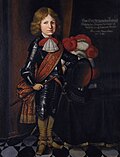 | 12 July 1657
Altenburg
Son of Frederick William II and Magdalene Sibylle of Saxony | 22 April 1669 – 14 April 1672 | Duchy of Altenburg | Unmarried | 14 April 1672
Altenburg
aged 14 |
| Elisabeth Sophie |  | 10 October 1619
Halle
Daughter of John Philip and Elisabeth of Brunswick-Wolfenbüttel | 14 April 1672 – 20 December 1680 | Duchy of Altenburg | Ernest I, Duke of Gotha
24 October 1636
Altenburg
eighteen children | 20 December 1680
Gotha
aged 61 | She was declared the general heiress of the family in case of the extinction of the male line, which eventually happened in her lifetime. |
| Saxe-Altenburg merged in Saxe-Gotha to form Saxe-Gotha-Altenburg |
| Frederick I |  | 15 July 1646
Gotha
First son of Ernest I and Elisabeth Sophie of Saxe-Altenburg | 26 March 1675 – 2 August 1691 | Duchy of Gotha and Altenburg
(in Gotha and Altenburg proper, jointly with his mother in Altenburg until 1680) | Magdalena Sibylle of Saxe-Weissenfels
14 November 1669
Halle
eight children
Christine of Baden-Durlach
14 August 1681
Ansbach
no children | 2 August 1691
Friedrichswerth
aged 45 | Children of Ernest I, divided their inheritance. |
| Albert V |  | 24 May 1648
Gotha
Second son of Ernest I and Elisabeth Sophie of Saxe-Altenburg | 26 March 1675 – 6 August 1699 | Duchy of Gotha and Altenburg
(at Coburg) | Marie Elisabeth of Brunswick-Wolfenbüttel
18 July 1676
Gotha
one child
Susanne Elisabeth Kempinsky
24 May 1688
Coburg
(morganatic)
no children | 6 August 1699
Coburg
aged 51 |
| Bernard I |  | 10 September 1649
Gotha
Third son of Ernest I and Elisabeth Sophie of Saxe-Altenburg | 26 March 1675 – 27 April 1706 | Duchy of Meiningen | Marie Hedwig of Hesse-Darmstadt
20 November 1671
Gotha
seven children
Elisabeth Eleonore of Brunswick-Wolfenbüttel
25 January 1681
Schöningen
five children | 27 April 1706
Meiningen
aged 56 |
| Henry |  | 19 November 1650
Gotha
Fourth son of Ernest I and Elisabeth Sophie of Saxe-Altenburg | 26 March 1675 – 13 May 1710 | Duchy of Gotha and Altenburg
(at Römhild) | Marie Elisabeth of Hesse-Darmstadt
1 March 1676
Darmstadt
no children | 13 May 1710
Römhild
aged 59 |
| Christian |  | 6 January 1653
Gotha
Fifth son of Ernest I and Elisabeth Sophie of Saxe-Altenburg | 26 March 1675 – 28 April 1707 | Duchy of Gotha and Altenburg
(at Eisenberg) | Christiane of Saxe-Merseburg
13 February 1677
Merseburg
one child
Sophie Marie of Hesse-Darmstadt
9 February 1681
Darmstadt
no children | 28 April 1707
Eisenberg
aged 54 |
| Ernest I |  | 12 June 1655
Gotha
Sixth son of Ernest I and Elisabeth Sophie of Saxe-Altenburg | 26 March 1675 – 17 October 1715 | Duchy of Hildburghausen | Sophie of Waldeck
30 November 1680
Arolsen
eighteen children | 17 October 1715
Hildburghausen
aged 60 |
| John Ernest |  | 22 August 1658
Gotha
Seventh son of Ernest I and Elisabeth Sophie of Saxe-Altenburg | 26 March 1675 – 17 February 1729 | Duchy of Saalfeld
(until 1699)
Duchy of Coburg and Saalfeld
(since 1699) | Sophie Hedwig of Saxe-Merseburg
18 February 1680
Merseburg
five children
Charlotte Johanna of Waldeck-Wildungen
2 December 1690
Maastricht
eight children | 17 February 1729
Saalfeld
aged 70 |
Coburg merged in Saxe-Saalfeld to form Saxe-Coburg-Saalfeld
Saxe-Römhild was annexed to Saxe-Coburg-Saalfeld
Saxe-Eisenberg was annexed by Saxe-Hildburghausen |
Regency of John Ernest II, Duke of Saxe-Weimar (1678–1683)
Regency of John George I, Duke of Saxe-Eisenach (1683–1686)
Regency of William Ernest, Duke of Saxe-Weimar (1686–1690) | Died as a minor. |
| John William | | 28 March 1675
Jena
Son of Bernard II and Marie Charlotte de la Trémoille | 3 May 1678 – 4 November 1690 | Duchy of Jena | Unmarried | 4 November 1690
Jena
aged 15 |
| Saxe-Jena divided between its neighbours Saxe-Eisenach and Saxe-Weimar |
| John Adolph I the Careful [14] |  | 2 November 1649
Halle
First son of Augustus and Anna Maria of Mecklenburg-Schwerin | 4 June 1680 – 24 May 1697 | Duchy of Weissenfels
(at Querfurt) | Johanna Magdalena of Saxe-Altenburg
25 October 1671
Altenburg
eleven children
Christiane Wilhelmine of Bünau
3 February 1692
Querfurt
(morganatic)
eleven children | 24 May 1697
Weissenfels
aged 47 | Children of Augustus, divided their inheritance. |
| Henry the Shooter-Up [14] |  | 29 September 1657
Halle
Second son of Augustus and Anna Maria of Mecklenburg-Schwerin | 4 June 1680 – 16 February 1728 | County of Barby | Elisabeth Albertine of Anhalt-Dessau
30 March 1686
Dessau
seven children | 16 February 1728
Barby
aged 70 |
| John George III | 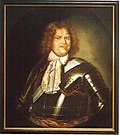 | 20 June 1647
Dresden
Son of John George II and Magdalene Sibylle of Brandenburg-Bayreuth | 22 August 1680 – 12 September 1691 | Electorate of Saxony | Anna Sophie of Denmark
9 October 1666
Copenhagen
two children | 12 September 1691
Tübingen
aged 44 | |
| Maurice William |  | 12 March 1664
Moritzburg Palace
First son of Maurice and Dorothea Maria of Saxe-Weimar | 4 December 1681 – 15 November 1718 | Duchy of Zeitz | Marie Amalie of Brandenburg
25 June 1689
Potsdam
five children | 15 November 1718
Osterburg Castle
aged 54 | Children of Maurice, divided their inheritance. After their deaths Zeitz and Peggau merged in the Electorate. |
| Frederick Henry |  | 21 July 1668
Moritzburg Palace
Second son of Maurice and Dorothea Maria of Saxe-Weimar | 4 December 1681 – 18 December 1713 | Duchy of Zeitz
(at Pegau and Neustadt) | Sophie Angelika of Württemberg-Oels
23 April 1699
Oleśnica
no children
Anna Frederica of Sonderburg-Wiesenburg
27 February 1702
Moritzburg
two children | 18 December 1713
Neustadt
aged 45 |
Saxe-Zeitz-Pegau-Neustadt merged in Saxe-Zeitz
Saxe-Zeitz merged in the Electorate of Saxony |
| William Ernest I |  | 19 October 1662
Weimar
First son of John Ernest II and Christine Elisabeth of Sonderburg | 15 May 1683 – 26 August 1728 | Duchy of Weimar | Charlotte Marie of Saxe-Jena
2 November 1683
Eisenach
no children | 26 August 1728
Weimar
aged 65 | Children of John Ernest II, ruled jointly. |
| John Ernest III | 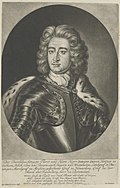 | 22 June 1664
Weimar
Second son of John Ernest II and Christine Elisabeth of Sonderburg | 15 May 1683 – 10 May 1707 | Sophie Auguste of Anhalt-Zerbst
11 October 1685
Zerbst
five children
Charlotte of Hesse-Homburg
4 November 1694
Kassel
four children | 10 May 1707
Weimar
aged 42 |
| John George II | 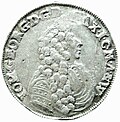 | 24 July 1665
Friedewald
First son of John George I and Johannetta of Sayn-Wittgenstein | 19 September 1686 – 10 November 1698 | Duchy of Eisenach | Sophie Charlotte of Württemberg
20 September 1688
Kirchheim unter Teck
no children | 10 November 1698
Eisenach
aged 33 | Left no descendants. He was succeeded by his brother. |
| Regency of Bernard I, Duke of Meiningen and Henry, Duke of Römhild (1691–1693) | |
| Frederick II |  | 28 July 1676
Gotha
Son of Frederick I and Magdalena Sibylle of Saxe-Weissenfels | 2 August 1691 – 23 March 1732 | Duchy of Gotha and Altenburg | Magdalena Augusta of Anhalt-Zerbst
7 June 1696
Gotha
nineteen children | 23 March 1732
Altenburg
aged 55 |
| John George IV |  | 18 October 1668
Dresden
First son of John George III and Anna Sophie of Denmark | 12 September 1691 – 27 April 1694 | Electorate of Saxony | Eleonore Erdmuthe of Saxe-Eisenach
17 April 1692
Leipzig
no children | 27 April 1694
Dresden
aged 25 | |
| Christian II | | 19 November 1653
Merseburg
First son of Christian I and Christiana of Sonderburg-Glücksburg | 18 October 1691 – 20 October 1694 | Duchy of Merseburg | Erdmuthe Dorothea of Saxe-Zeitz
14 October 1679
Moritzburg
seven children | 20 October 1694
Merseburg
aged 40 | Children of Christian I, divided their inheritance. Zörbig eventually re-merged in Merseburg. |
| Augustus | | 15 February 1655
Merseburg
Second son of Christian I and Christiana of Sonderburg-Glücksburg | 18 October 1691 – 27 March 1715 | Duchy of Merseburg
(at Zörbig) | Hedwig of Mecklenburg-Güstrow
1 December 1686
Güstrow
eight children | 27 March 1715
Zörbig
aged 60 |
| Frederick Augustus I the Strong |  | 12 May 1670
Dresden
Second son of John George III and Anna Sophie of Denmark | 27 April 1694 – 1 February 1733 | Electorate of Saxony | Christiane Eberhardine of Brandenburg-Bayreuth
20 January 1693
Bayreuth
one child | 1 February 1733
Warsaw
aged 62 | Converted to Catholicism in 1697 in order to compete for the crown of Poland. Took the Polish crown in 1697, opposed by Stanisław Leszczyński since 1704. |
| Regency of Erdmuthe Dorothea of Saxe-Zeitz and Frederick Augustus I, Elector of Saxony (1694) | Left no descendants. He was succeeded by his also minor brother. |
| Christian III Maurice | | 7 November 1680
Merseburg
First son of Christian II and Erdmuthe Dorothea of Saxe-Zeitz | 20 October – 14 November 1694 | Duchy of Merseburg | Unmarried | 14 November 1694
Merseburg
aged 14 |
| Regency of Erdmuthe Dorothea of Saxe-Zeitz and Frederick Augustus I, Elector of Saxony (1694–1712) | Left no descendants. He was succeeded by his uncle, Henry. |
| Maurice William |  | 5 February 1688
Merseburg
Second son of Christian II and Erdmuthe Dorothea of Saxe-Zeitz | 14 November 1694 – 21 April 1731 | Duchy of Merseburg | Henriette Charlotte of Nassau-Idstein
4 November 1711
Istein
one child | 21 April 1731
Merseburg
aged |
| Henry |  | 2 September 1661
Merseburg
Fourth son of Christian I and Christiana of Sonderburg-Glücksburg | 21 April 1731 – 28 July 1738 | Duchy of Merseburg
(at Spremberg since 1691) | Elisabeth of Mecklenburg-Güstrow
29 March 1692
Güstrow
three children | 28 July 1738
Doberlug-Kirchhain
aged 76 | Received, after his father's death, the town of Spremberg. In 1731 succeeded in Merseburg, reuniting its original lands with those he unexpectedly inherited. Left no descendants and Merseburg merged in the Electorate of Saxony. |
Saxe-Merseburg-Spremberg merged in Saxe-Merseburg
Saxe-Merseburg merged in the Electorate of Saxony |
| John George |  | 13 July 1677
Halle
First son of John Adolph I and Johanna Magdalena of Saxe-Altenburg | 24 May 1697 – 16 March 1712 | Duchy of Weissenfels
(at Querfurt) | Fredericka Elisabeth of Saxe-Eisenach
7 January 1698
Jena
seven children | 16 March 1712
Weissenfels
aged 34 | In 1711, John George gave his uncle Frederick the town of Dahme, which after his death was re-absorbed by Weissenfels. John George died without male descendants, and was succeeded by his brother Christian. |
| Frederick | 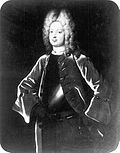 | 20 November 1673
Halle
Third son of Augustus and Johanna Walpurgis of Leiningen-Westerburg | 1711 – 16 April 1715 | Duchy of Weissenfels
(at Dahme) | Emilie Agnes Reuss of Schleiz
13 February 1711
Dahme
no children | 16 April 1715
Dahme
aged 41 |
| John William III |  | 17 October 1666
Friedewald
Second son of John George I and Johannetta of Sayn-Wittgenstein | 10 November 1698 – 14 January 1729 | Duchy of Eisenach | Amalie of Nassau-Dietz
28 November 1690
Oranjewoud
two children
Christine Juliane of Baden-Durlach
27 February 1697
Wolfenbüttel
seven children
Magdalene Sibylle of Saxe-Weissenfels
28 July 1708
Weissenfels
three children
Marie Christine Felizitas of Leiningen-Dagsburg-Falkenburg-Heidesheim
29 May 1727
Hanau
no children | 14 January 1729
Eisenach
aged 62 | |
| Ernest Louis I |  | 7 October 1672
Gotha
First son of Bernard I and Marie Hedwig of Hesse-Darmstadt | 27 April 1706 – 24 November 1724 | Duchy of Meiningen | Dorothea Marie of Saxe-Gotha-Altenburg
19 September 1704
Gotha
five children
Elisabeth Sophie of Brandenburg
3 June 1714
Coburg
no children | 24 November 1724
Meiningen
aged 52 | |
| Christian |  | 23 February 1682
Weissenfels
Second son of John Adolph I and Johanna Magdalena of Saxe-Altenburg | 16 March 1712 – 28 June 1736 | Duchy of Weissenfels
(at Querfurt) | Louise Christine of Stolberg-Stolberg-Ortenberg
12 May 1712
Stolberg
no children | 28 June 1736
Sangerhausen
aged 54 | Left no male descendants. He was succeeded by his brother John Adolf. |
| Ernest Frederick I |  | 21 August 1681
Gotha
Son of Ernest and Sophie Henriette of Waldeck | 17 October 1715 – 9 March 1724 | Duchy of Hildburghausen | Sophia Albertine of Erbach-Erbach
4 February 1704
Erbach im Odenwald
fourteen children | 9 March 1724
Hildburghausen
aged 42 | |
| Regency of Sophia Albertine of Erbach-Erbach (1724–1728) | |
| Ernest Frederick II |  | 17 December 1707
Hildburghausen
Son of Ernest Frederick I and Sophia Albertine of Erbach-Erbach | 9 March 1724 – 13 August 1745 | Duchy of Hildburghausen | Caroline of Erbach-Fürstenau
19 June 1726
Fürstenau
four children | 13 August 1745
Hildburghausen
aged 37 |
| Regency of Frederick William of Saxe-Meiningen (1724–1733), Frederick II, Duke of Gotha and Altenburg (1724–1732) and Anton Ulrich of Saxe-Meiningen (1732–1733) | Children of Ernest Louis I, ruled jointly. Both left no descendants, and were succeeded by their uncles and previous regents. |
| Ernest Louis II |  | 8 August 1709
Coburg
First son of Ernest Louis I and Dorothea Marie of Saxe-Gotha-Altenburg | 24 November 1724 – 24 February 1729 | Duchy of Meiningen | Unmarried | 24 February 1729
Meiningen
aged 28 |
| Charles Frederick |  | 18 July 1712
Meiningen
Second son of Ernest Louis I and Dorothea Marie of Saxe-Gotha-Altenburg | 24 November 1724 – 28 March 1743 | 28 March 1743
Meiningen
aged 30 |
| George Albert |  | 19 April 1695
Dessau
Son of Henry and Elisabeth Albertine of Anhalt-Dessau | 16 February 1728 – 12 June 1739 | County of Barby | Auguste Louise of Württemberg-Oels
18 February 1721
Forst
no children | 12 June 1739
Barby
aged 44 | Left no descendants, and his land merged in Saxe-Weissenfels. |
| Barby re-merged in Saxe-Weissenfels |
| Ernest Augustus I |  | 19 April 1688
Weimar
Son of John Ernest III and Sophie Auguste of Anhalt-Zerbst | 26 August 1728 – 19 January 1748 | Duchy of Weimar
(until 1741)
Duchy of Weimar and Eisenach
(from 1741) | Eleonore Wilhelmine of Anhalt-Köthen
2 November 1683
Nienburg
eight children
Sophie Charlotte of Brandenburg-Bayreuth
7 April 1734
Bayreuth
four children | 19 January 1748
Eisenach
aged 59 | Co-ruled with William Ernest since 1707. Reunited under his rule the duchies of Weimar and Eisenach. |
| William Henry |  | 10 November 1691
Oranjewoud
Son of John William III and Amalia of Nassau-Dietz [ it ] | 14 January 1729 – 26 July 1741 | Duchy of Eisenach | Albertine Juliane of Nassau-Idstein [ bg ]
15 February 1713
Idstein
no children
Anna Sophie Charlotte of Brandenburg-Schwedt
3 June 1723
Berlin
no children | 26 July 1741
Eisenach
aged 49 | Left no descendants: Saxe-Eisenach merged with Saxe-Weimar. |
| Saxe-Eisenach merged in Saxe-Weimar to form Saxe-Weimar-Eisenach |
| Christian Ernest |  | 18 August 1683
Saalfeld
Son of John Ernest and Sophie Hedwig of Saxe-Merseburg | 17 February 1729 – 4 September 1745 | Duchy of Coburg and Saalfeld | Christiane Fredericka of Koss
18 August 1724
Naitschau
(morganatic)
no children | 4 September 1745
Saalfeld
aged 62 | Left no descendants. He was succeeded by his brother. |
| Frederick III |  | 14 April 1699
Gotha
Son of Frederick II and Magdalene Augusta of Anhalt-Zerbst | 23 March 1732 – 10 March 1772 | Duchy of Gotha and Altenburg | Luise Dorothea of Saxe-Meiningen
17 September 1729
Gotha
eight children | 10 March 1772
Gotha
aged 72 | |
| Frederick Augustus II the Fat |  | 17 October 1696
Dresden
Son of Frederick Augustus I and Christiane Eberhardine of Brandenburg-Bayreuth | 1 February 1733 – 5 October 1763 | Electorate of Saxony | Maria Josepha of Austria
20 August 1719
Dresden
sixteen children | 5 October 1763
Dresden
aged 66 | Converted to Catholicism in 1712. King of Poland 1734–1763. |
| John Adolph II | 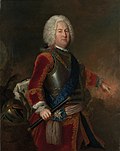 | 4 September 1685
Weissenfels
Son of Christian and Louise Christine of Stolberg-Stolberg-Ortenberg | 28 June 1736 – 16 May 1746 | Duchy of Weissenfels
(at Querfurt) | Johannette Antoinette Juliane of Saxe-Eisenach
9 May 1721
Eisenach
one child
Frederica of Saxe-Gotha and Altenburg
27 November 1734
Altenburg
five children | 16 May 1746
Leipzig
aged 60 | Left no male descendants. After his death the Duchy was reannexed by the Electorate of Saxony. |
| Saxe-Weissenfels-Querfurt (with exceptions) merged in the Electorate of Saxony |
| Frederick William | 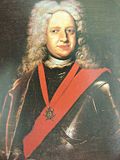 | 16 February 1679
Ichtershausen
Second son of Bernard I and Marie Hedwig of Hesse-Darmstadt | 28 March 1743 – 10 March 1746 | Duchy of Meiningen | Unmarried | 10 March 1746
Meiningen
aged 67 | Brothers of Ernest Louis I, succeeded their nephews after their deaths with no descendants. |
| Anton Ulrich |  | 22 October 1687
Meiningen
Son of Bernard I and Elisabeth Eleonore of Brunswick-Wolfenbüttel | 28 March 1743 – 27 January 1763 | Philippine Elisabeth Caesar
January 1711
(morganatic)
ten children
Charlotte Amalie of Hesse-Philippsthal
26 September 1750
Bad Homburg vor der Höhe
eight children | 27 January 1763
Frankfurt
aged 75 |
| Regency of Caroline of Erbach-Fürstenau (1745–1748) | |
| Ernest Frederick III |  | 10 June 1727
Königsberg
Son of Ernest Frederick II and Caroline of Erbach-Fürstenau | 13 August 1745 – 23 September 1780 | Duchy of Hildburghausen | Louise of Denmark
1 October 1749
Copenhagen
one child
Christiane Sophie Charlotte of Brandenburg-Bayreuth
20 January 1757
Copenhagen
one child
Ernestine of Saxe-Weimar
1 July 1758
Bayreuth
three children | 23 September 1780
Straufhain
aged 53 |
| Francis Josias |  | 25 September 1697
Saalfeld
Son of John Ernest and Charlotte Johanna of Waldeck-Wildungen | 4 September 1745 – 16 September 1764 | Duchy of Coburg and Saalfeld | Anna Sophie of Schwarzburg-Rudolstadt
2 January 1723
Rudolstadt
eight children | 16 September 1764
Bad Rodach
aged 66 | |
| Frederica of Saxe-Gotha and Altenburg |  | 17 July 1715
Weissenfels
Daughter of Frederick II, Duke of Gotha and Altenburg and Magdalena Augusta of Anhalt-Zerbst | 16 May 1746 – 2 May 1775 | Duchy of Weissenfels
(at Langensalza) | John Adolph II
27 November 1734
Altenburg
five children | 2 May 1775
Langensalza
aged 59 | Inherited fom her husband a seat in Langensalza, where she ruled until her death. |
| Langensalza annexed to the Electorate of Saxony |
| Regency of Francis Josias, Duke of Coburg and Saalfeld (1748–1755) | |
| Ernest Augustus II |  | 2 June 1737
Weimar
Son of Ernest Augustus I and Sophie Charlotte of Brandenburg-Bayreuth | 19 January 1748 – 28 May 1758 | Duchy of Weimar and Eisenach | Anna Amalia of Brunswick-Wolfenbüttel
16 March 1756
Brunswick
two children | 28 May 1758
Weimar
aged 20 |
| Regency of Anna Amalia of Brunswick-Wolfenbüttel (1758–1775) | In 1815, his Duchy was elevated to a Grand Duchy. |
| Charles Augustus | 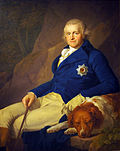 | 3 September 1757
Weimar
Son of Ernest Augustus II and Anna Amalia of Brunswick-Wolfenbüttel | 28 May 1758 – 14 June 1828 | Duchy of Weimar and Eisenach
(until 1815)
Grand Duchy of Weimar and Eisenach
(from 1815) | Louise of Hesse-Darmstadt
3 October 1775
Karlsruhe
seven children | 14 June 1828
Graditz
aged 70 |
| Regency of Charlotte Amalie of Hesse-Philippsthal (1763–1779) | Left no descendants. He was succeeded by his brother. |
| Charles William |  | 19 November 1754
Frankfurt
First son of Anton Ulrich and Charlotte Amalie of Hesse-Philippsthal | 27 January 1763 – 21 January 1782 | Duchy of Meiningen | Louise of Stolberg-Gedern
5 June 1780
Gedern
no children | 21 January 1782
Sonneberg
aged 27 |
| Frederick Christian |  | 5 September 1722
Dresden Castle
Son of Frederick Augustus II and Maria Josepha of Austria | 5 October – 17 December 1763 | Electorate of Saxony | Maria Antonia of Bavaria
13 June 1747
Munich
(by proxy)
20 June 1747
Dresden
(in person)
nine children | 17 December 1763
Dresden Castle
aged 41 | Raised Catholic. After 74 days of reign, died of smallpox. |
| Regency of Maria Antonia of Bavaria and Prince Francis Xavier of Saxony (1763–1768) | His Electorate ceased with the fall of the Holy Roman Empire in 1806, and he became king of the newly independent Kingdom of Saxony. Also Duke of Warsaw 1807–1813. Left no male descendants. He was succeeded by his brother. |
| Frederick Augustus III & I the Just |  | 23 December 1750
Dresden
First son of Frederick Christian and Maria Antonia of Bavaria | 17 December 1763 – 20 December 1806
20 December 1806 – 5 May 1827 | Electorate of Saxony
(until 1806)
Kingdom of Saxony
(from 1806) | Amalie of Zweibrücken-Birkenfeld
17 January 1769
Mannheim
(by proxy)
29 January 1769
Dresden
(in person)
four children | 5 May 1827
Dresden
aged 76 |
| Ernest Frederick |  | 8 March 1724
Saalfeld
Son of Francis Josias and Anna Sophie of Schwarzburg-Rudolstadt | 16 September 1764 – 8 September 1800 | Duchy of Coburg and Saalfeld | Sophie Antonia of Brunswick-Wolfenbüttel
23 April 1749
Wolfenbüttel
seven children | 8 September 1800
Coburg
aged 76 | |
| Ernest II | 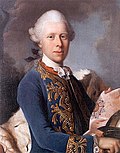 | 30 January 1745
Gotha
Son of Frederick III and Luise Dorothea of Saxe-Meiningen | 10 March 1772 – 20 April 1804 | Duchy of Gotha and Altenburg | Charlotte of Saxe-Meiningen
21 March 1769
Meiningen
four children | 20 April 1804
Gotha
aged 59 | |
| Regency of Prince Joseph of Saxe-Hildburghausen (1780–1787) | Inherited Altenburg from Frederick IV, and renamed his duchy as Saxe-Altenburg. |
| Frederick |  | 29 April 1763
Hildburghausen
Son of Ernest Frederick III and Ernestine of Saxe-Weimar | 23 September 1780 – 29 September 1834 | Duchy of Hildburghausen
(until 1826)
Duchy of Altenburg
(fom 1826) | Charlotte Georgine of Mecklenburg-Strelitz
3 September 1785
Hildburghausen
twelve children | 29 September 1834
Altenburg
aged 71 |
| George I |  | 4 February 1761
Meiningen
Second son of Anton Ulrich and Charlotte Amalie of Hesse-Philippsthal | 21 January 1782 – 24 December 1803 | Duchy of Meiningen | Louise Eleonore of Hohenlohe-Langenburg
27 November 1782
Langenburg
four children | 24 December 1803
Meiningen
aged 42 | |
| Francis |  | 15 July 1750
Coburg
Son of Ernest Frederick and Sophie Antonia of Brunswick-Wolfenbüttel | 8 September 1800 – 9 December 1806 | Duchy of Coburg and Saalfeld | Sophie of Saxe-Hildburghausen
6 March 1776
Hildburghausen
no children
Augusta Reuss of Ebersdorf
13 June 1777
Ebersdorf
ten children | 9 December 1806
Coburg
aged 56 | |
| Regency of Louise Eleonore of Hohenlohe-Langenburg (1803–1821) | |
| Bernard II |  | 17 December 1800
Son of George I and Louise Eleonore of Hohenlohe-Langenburg | 24 September 1803 – 20 September 1866 | Duchy of Meiningen | Marie Frederica of Hesse-Kassel
23 March 1825
Kassel
two children | 3 December 1882
aged 81 |
| Augustus |  | 23 November 1772
Gotha
First son of Ernest II and Charlotte of Saxe-Meiningen | 20 April 1804 – 17 May 1822 | Duchy of Gotha and Altenburg | Louise Charlotte of Mecklenburg-Schwerin
21 October 1797
Ludwigslust
one child
Karoline Amalie of Hesse-Kassel
24 April 1802
Kassel
no children | 17 May 1822
Gotha
aged 49 | Left no male descendants. The land was inherited by his brother Frederick IV. |
| Ernest I |  | 2 January 1784
Coburg
Son of Francis and Augusta Reuss of Ebersdorf | 9 December 1806 – 29 January 1844 | Duchy of Coburg and Saalfeld
(until 1826)
Duchy of Coburg and Gotha
(from 1826) | Louise of Saxe-Gotha-Altenburg
3 July 1817
Gotha
two children
Marie of Württemberg
23 December 1832
Coburg
no children | 29 January 1844
Gotha
aged 60 | Inherited Gotha from Frederick IV, but had to cede Saalfeld to Meiningen. The duchy changed its name to Saxe-Coburg and Gotha |
| Frederick IV |  | 28 November 1774
Gotha
Second son of Ernest II and Charlotte of Saxe-Meiningen | 17 May 1822 – 11 February 1825 | Duchy of Gotha and Altenburg | Unmarried | 11 February 1825
Gotha
aged 50 | Left no male descendants. The territory was divided between Saxe-Coburg-Saalfeld and Saxe-Hildburghausen. |
| Saxe-Gotha-Altenburg divided between its neighbours Saxe-Coburg-Saalfeld and Saxe-Hildburghausen |
| Anthony the Kind |  | 27 December 1755
Dresden
Second son of Frederick Christian and Maria Antonia of Bavaria | 5 May 1827 – 6 June 1836 | Kingdom of Saxony | Maria Carolina of Savoy
29 September 1781
Stupinigi
(by proxy)
24 October 1781
Dresden
(in person)
no children
Maria Theresa of Austria
8 September 1787
Florence
(by proxy)
18 October 1787
Dresden
(in person)
four children | 6 June 1836
Dresden
aged 80 | Left no male descendants. He was succeeded by his nephew. |
| Charles Frederick |  | 2 February 1783
Weimar
Son of Charles Augustus and Louise of Hesse-Darmstadt | 14 June 1828 – 8 July 1853 | Grand Duchy of Weimar and Eisenach | Maria Pavlovna of Russia
3 August 1804
St. Petersburg
four children | 8 July 1853
Schloss Belvedere
aged 70 | |
| Joseph |  | 27 August 1789
Hildburghausen
First son of Frederick and Charlotte Georgine of Mecklenburg-Strelitz | 29 September 1834 – 30 November 1848 | Duchy of Altenburg | Amelia of Württemberg
24 April 1817
Kirchheim unter Teck
six children | 25 November 1868
Altenburg
aged 79 | He implemented several buildings in Altenburg, but his government was considered conservative and resistant to reform; for this, he was forced to abdicate during the civil revolution of 1848. Left no male descendants. He was succeeded by his brother George. |
| Frederick Augustus II |  | 18 May 1797
Pillnitz
First son of Prince Maximilian of Saxony and Princess Caroline of Parma | 6 June 1836 – 9 August 1854 | Kingdom of Saxony | Maria Carolina of Austria
26 September 1819
Vienna
(by proxy)
7 October 1819
Dresden
(by person)
no children
Maria Anna of Bavaria
24 April 1833
Dresden
no children | 9 August 1854
Karrösten
aged 57 | Left no descendants. He was succeeded by his brother. |
| Ernest II |  | 21 June 1818
Ehrenburg Palace
Son of Ernest I and Louise of Saxe-Gotha and Altenburg | 29 January 1844 – 22 August 1893 | Duchy of Coburg and Gotha | Alexandrine of Baden
3 May 1842
Karlsruhe
no children | 22 August 1893
Reinhardsbrunn
aged 75 | Left no descendants. He was succeeded by his nephews. |
| George |  | 24 July 1796
Hildburghausen
Second son of Frederick and Charlotte Georgine of Mecklenburg-Strelitz | 30 November 1848 – 3 August 1853 | Duchy of Altenburg | Marie Louise of Mecklenburg-Schwerin
7 October 1825
Ludwigslust
three children | 3 August 1853
Hummelshain
aged 57 | |
| Charles Alexander |  | 24 June 1818
Weimar
Son of Charles Frederick and Maria Pavlovna of Russia | 8 July 1853 – 5 January 1901 | Grand Duchy of Weimar and Eisenach | Sophie of the Netherlands
8 October 1842
The Hague
four children | 5 January 1901
Weimar
aged 82 | |
| Ernest I |  | 16 February 1826
Hildburghausen
Son of George and Marie Louise of Mecklenburg-Schwerin | 3 August 1853 – 7 February 1908 | Duchy of Altenburg | Agnes of Anhalt-Dessau
28 April 1853
Ludwigslust
two children | 7 February 1908
Altenburg
aged 81 | Left no male descendants. He was succeeded by his nephew. |
| John |  | 12 December 1801
Dresden
Second son of Prince Maximilian of Saxony and Princess Caroline of Parma | 9 August 1854 – 29 October 1873 | Kingdom of Saxony | Amalie Auguste of Bavaria
10 November 1822
Munich
(by proxy)
21 November 1822
Dresden
(in person)
nine children | 29 October 1873
Pillnitz
aged 71 | Became a subordinate ruler in the German Empire after the Unification of Germany in 1871. |
| George II | 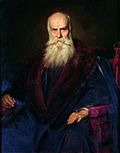 | 2 April 1826
Son of Bernard II and Marie Fredericka of Hesse-Kassel | 20 September 1866 – 25 June 1914 | Duchy of Meiningen | Charlotte of Prussia
18 May 1850
Berlin
four children
Feodora of Hohenlohe-Langenburg
23 October 1858
Langenburg
three children
Ellen Franz
18 March 1873
Liebenstein
(morganatic)
no children | 25 June 1914
Bad Wildungen
aged 88 | |
| Albert the Good |  | 23 April 1828
Dresden
First son of John and Amalie Auguste of Bavaria | 29 October 1873 – 19 June 1902 | Kingdom of Saxony | Carola of Sweden
18 June 1853
Dresden
no children | 19 June 1902
Szczodre
aged 74 | |
| Alfred |  | 6 August 1844
Windsor Castle
Son of Prince Albert of Saxe-Coburg and Gotha and Victoria, Queen of the United Kingdom | 22 August 1893 – 30 July 1900 | Duchy of Coburg and Gotha | Maria Alexandrovna of Russia
23 January 1874
St Petersburg
six children | 30 July 1900
Schloss Rosenau, Coburg
aged 55 | Nephew of Ernest II. |
| Regency of Prince Ernst of Hohenlohe-Langenburg (1900–1905) | Nephew of Alfred. Monarchy abolished in 1918. |
| Charles Edward |  | 19 July 1884
Claremont
Son of Prince Leopold of the United Kingdom and Princess Helena of Waldeck and Pyrmont | 30 July 1900 – 13 November 1918 | Duchy of Coburg and Gotha | Victoria Adelaide of Schleswig-Holstein
11 October 1905
Schleswig
five children | 6 March 1954
Coburg
aged 69> |
| William Ernest |  | 10 June 1876
Weimar
Son of Prince Charles Augustus of Saxe-Weimar and Eisenach and Princess Pauline of Saxe-Weimar and Eisenach | 5 January 1901 – 13 November 1918 | Grand Duchy of Weimar and Eisenach | Caroline Reuss of Greiz
30 April 1903
Bückeburg
no children
Feodora of Saxe-Meiningen
14 January 1910
Meiningen
four children | 24 April 1923
Henryków
aged 46 | Grandson of Charles Alexander, as son of Charles Augustus, Hereditary Grand Duke of Saxe-Weimar-Eisenach. Monarchy abolished in 1918. |
| George |  | 8 August 1832
Dresden
Second son of John and Amalie Auguste of Bavaria | 19 June 1902 – 15 October 1904 | Kingdom of Saxony | Maria Anna of Portugal
11 May 1859
Lisbon
eight children | 15 October 1904
Pillnitz
aged 72 | |
| Frederick Augustus III |  | 25 May 1865
Dresden
Son of George and Maria Anna of Portugal | 15 October 1904 – 13 November 1918 | Kingdom of Saxony | Louise of Austria
21 November 1891
Vienna
(annulled by royal decree in 1903, after her escape from court)
seven children | 18 February 1932
Szczodre
aged 66 | The last King of Saxony. Abdicated voluntarily in the German Revolution of 1918–1919. [19] |
| Ernest II |  | 31 August 1871
Altenburg
Son of Prince Maurice of Saxe-Altenburg and Princess Augusta of Saxe-Meiningen | 7 February 1908 – 13 November 1918 | Duchy of Altenburg | Adelaide of Schaumburg-Lippe
17 February 1898
Bückeburg
(annulled 1920)
four children
Maria Triebel
15 July 1934
Trockenborn-Wolfersdorf
(morganatic)
no children | 22 March 1955
Trockenborn-Wolfersdorf
aged 83 | Grandson of George and nephew of Ernest I. Monarchy abolished in 1918. |
| Bernard III |  | 1 April 1851
Meiningen
Son of George II and Charlotte of Prussia | 25 June 1914 – 13 November 1918 | Duchy of Meiningen | Charlotte of Prussia
18 February 1878
Berlin
two children | 16 January 1928
Meiningen
aged 76 | Monarchy abolished in 1918. |
